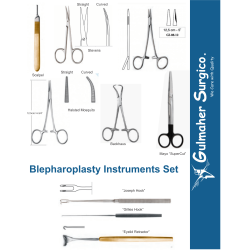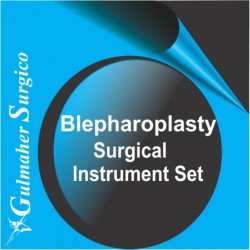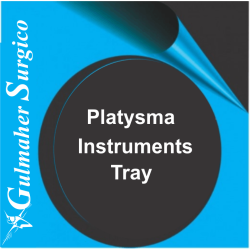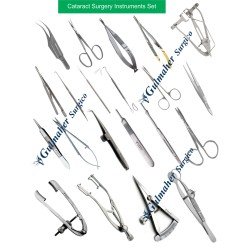
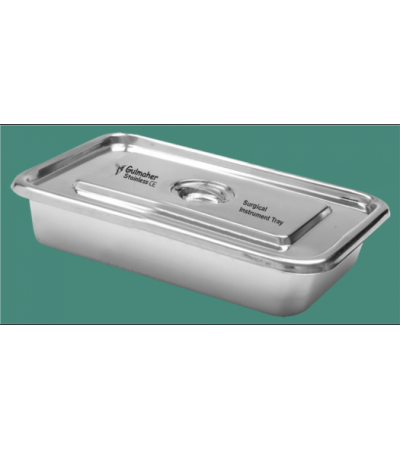
-25 %


Blepharoplasty Instruments Tray
$299.00
$399.00
- Stock: In Stock
- Article #: Blephset-002
Blepharoplasty Instruments Owing to the shortage of a typical nomenclature across various manufacturers, the outline of blepharoplasty surgical instrumentation remains nebulous among surgeons, surgical staff, and trainees of all levels. The instruments discussed below are found altogether surgical trays used for oculofacial cosmetic surgery or eye plastic surgery at the University of Iowa.
- Blepharoplasty instruments Tray Set consisting of the following tools.
Stevens Tenotomy Scissors, Blunt, Curved,11 cm, 4-1/2" 1
Iris Scissors, Flat Shanks, 10 cm, 4", Curved 1
Blepharoplasty Scissors, Sharp, Bevel Blades, Cvd, 4" 1
Kaye Blepharoplasty Rake, 5 Prong, Large, 13 cm, 5-1/4" 2
Castroviejo Suture Forceps, 10.5 cm, 4-1/4", 5 mm Tip 1
Castroviejo Suture Forceps, 10.5 cm, 4-1/4", 9 mm Tip 1
Total………………….23
- Sterilization: Surgical instruments may be steam autoclaved at a temperature of 121°C (250°F) for 30 minutes or flash autoclaved at a temperature of 127° to 132°C (260° to 270°F) for 10 minutes.
- Recommended Sterilization Parameters: PRE-VAC Unwrapped Goods Cycle 5 minutes at 132° C/270° F. Dry Time: none recommended.
Wrapped Goods Cycle 5 minutes @ 132° C/270° F Dry Time: 5‐20 minutes*
- Recommended Gravity. Unwrapped Goods Cycle 10 minutes @ 132° C/270° F Dry time: none recommended. Wrapped Goods Cycle 30 Minutes @ 132° C/270° F Dry Time: per facility recommendation. Wrapped Goods Cycle 60 Minutes @ 132° C/270° F Dry Time: per facility recommendation. *Depending on Hospital Protocol* Warning: Flash sterilization is not the recommended sterilization method. All surgical instruments and parts should be steam autoclaved when time permits. However, flash sterilization may be used when there is an immediate need for an instrument, injector, or accessory and there is no other alternative.
- Aeration: As required to return to room temperature or to start the next cycle.
- Contraindication: Hospital policy and procedure(s) take precedence over this protocol. Failure to use approved cleaning and sterilization procedures may void the warranty.
- Cleaning Instructions: Cleaning: All instruments must be cleaned to remove contaminated substances before sterilization. After each use, perform an initial cleaning within the sterile field by wiping the tool or instrument free of blood and body fluids. Then clean the instrument thoroughly with a mild soapy solution. Do not use alkaline-based cleaners. Complete preparation for sterilization by hospital procedure using an approved cleaning agent. Do not run any type of abrasive materials or steel brushes through the lumen of the tool. The abrasive material can score the inside of the tool, rendering them inefficient. After flushing, the instrument needs to be well-rinsed with warm to hot water. Visually inspect each instrument to ensure all fatty deposits are removed. All instruments should be cleaned and rinsed with mild, non-abrasive, grease-removing cleaners before they are sterilized. Gulmaher Instruments recommends that during the cleaning and rinsing procedures, all instruments should be inspected. Ultrasonic cleaning after manual cleaning is recommended.
1) DELIVERY TIMES CALE.
All orders received through the Gulmaher Surgico website are processed and, if the stock is available, despatched within 4 working days of receiving the order. Therefore, your ordered products will have to go through a production process, and the production period may vary according to the number of products and quantity, which may be 1-4 weeks.
2) LOST PACKAGE.
On rare occasions, we do experience losses whilst in transit. Please allow 10 days for the package to arrive from the date of despatch. If this time elapses and the goods do not arrive, please contact your nearest relevant courier office to check that no goods are being held. In the unlikely event that the package is not being held, please contact our Customer Services team who will be happy to assist in sending a replacement.
Please be aware that if we are not contacted within 3 weeks, an insurance claim cannot be made and thus you will be unable to claim any loss from Gulmaher Surgico.
3) TRACK AN ORDER.
For all your orders simply retrieve your tracking number from your account and then visit the relevant Courrier Website and track the order using their functionality.
Refund / Return Goods Policy
Any return must be assigned an RAN (Return Authorization Number) before it can be processed. Please contact a Customer Service Representative for return authorization. Returned merchandise will not be processed without an RAN#.
Customers have 30 days from the date of purchase to return an item for full credit.
- Item must be in unused condition and the original packaging Or unopened. Sterilized, taped, modified, or abused items cannot be returned or refunded for credit.
- The customer is responsible for returning the item(s) to Gulmaher. Gumaher will issue merchandise return labels if the return is a result of Gulmaher's mishandling (shipping error, etc.).
Credit will be applied to the original method of payment for the order.
After 30 days the following restocking fees apply:
•After 30 days 25% restocking fee
•After 45 days 50% restocking fee
No returns are accepted after 60 days.
The following types of merchandise cannot be accepted for Refund/return:
A.Custom Made Instruments
B.Special Orders / Discounted Invoice Products.
C.Discontinued Products
D.Implants or Sterile Products Not in Original Unopened Package
E.Merchandise Held Longer Than 60 Days
In the event of a defective product, the product must be reported to Gulmaher Surgico within 10 days of receipt of the goods or the claim will not be honored.
Please contact a Gulmaher Customer Service Representative with any questions. Thank you.
Related
Blepharoplasty Set eyelid surgery instrumentsMaterial: Stainless SteelFinish: SatinPacking: Instruments box.Detail of Blepharoplasty Instruments set.
..
$150.00 $250.00
The Blepharoplasty surgical instrument set is designed for reconstructive surgery around the eyes to rejuvenate saggy and fatty skin. Blepharoplasty s..
$250.00 $400.00
We are a key manufacturer of Chalazion surgery & surgical instruments and exporting worldwide since 2007. Our Chalazion surgery and
surgical inst..
$150.00
Platysma Surgery instruments Tray Set consisting of the following Surgical tools.Kaye Face Lift Scissors, Curved, Serrated,18.5 cm, 7-1/4" 1Rees Face ..
$275.00
A basic plastic surgery instrument set typically includes a variety of tools designed to perform precise surgical procedures. Here's a list of some co..
$149.00 $250.00
Minor
Basic surgical instrument Set directly linked with surgical procedure or
operating room. Minor Basic surgical instrument set covers all basic ..
$299.00 $399.00
Cataract surgery instruments set—Ophthalmic Tools are designed for specific tasks during the procedure. Here’s a list of instruments used for cataract..
$999.00 $1,499.00

